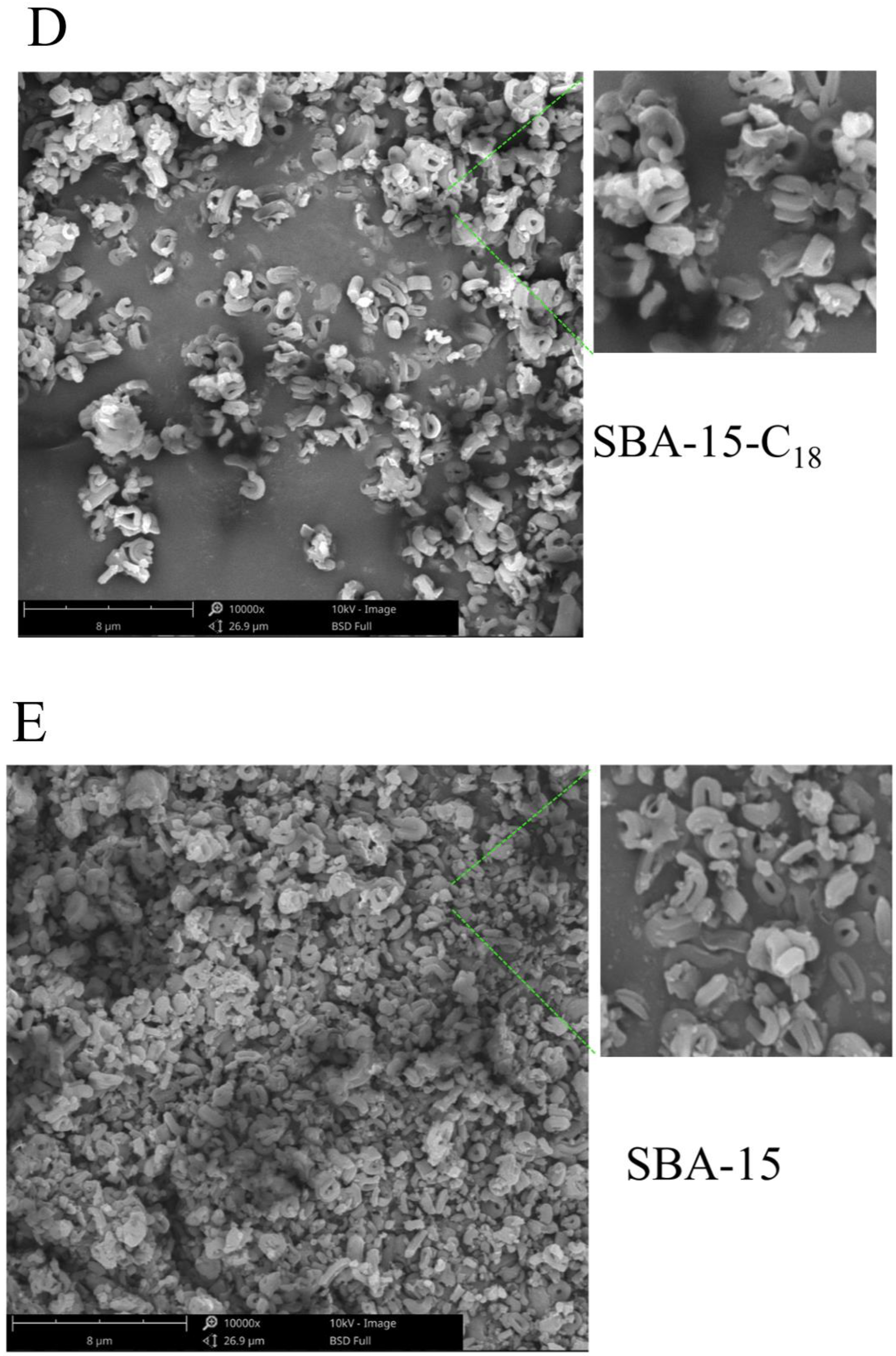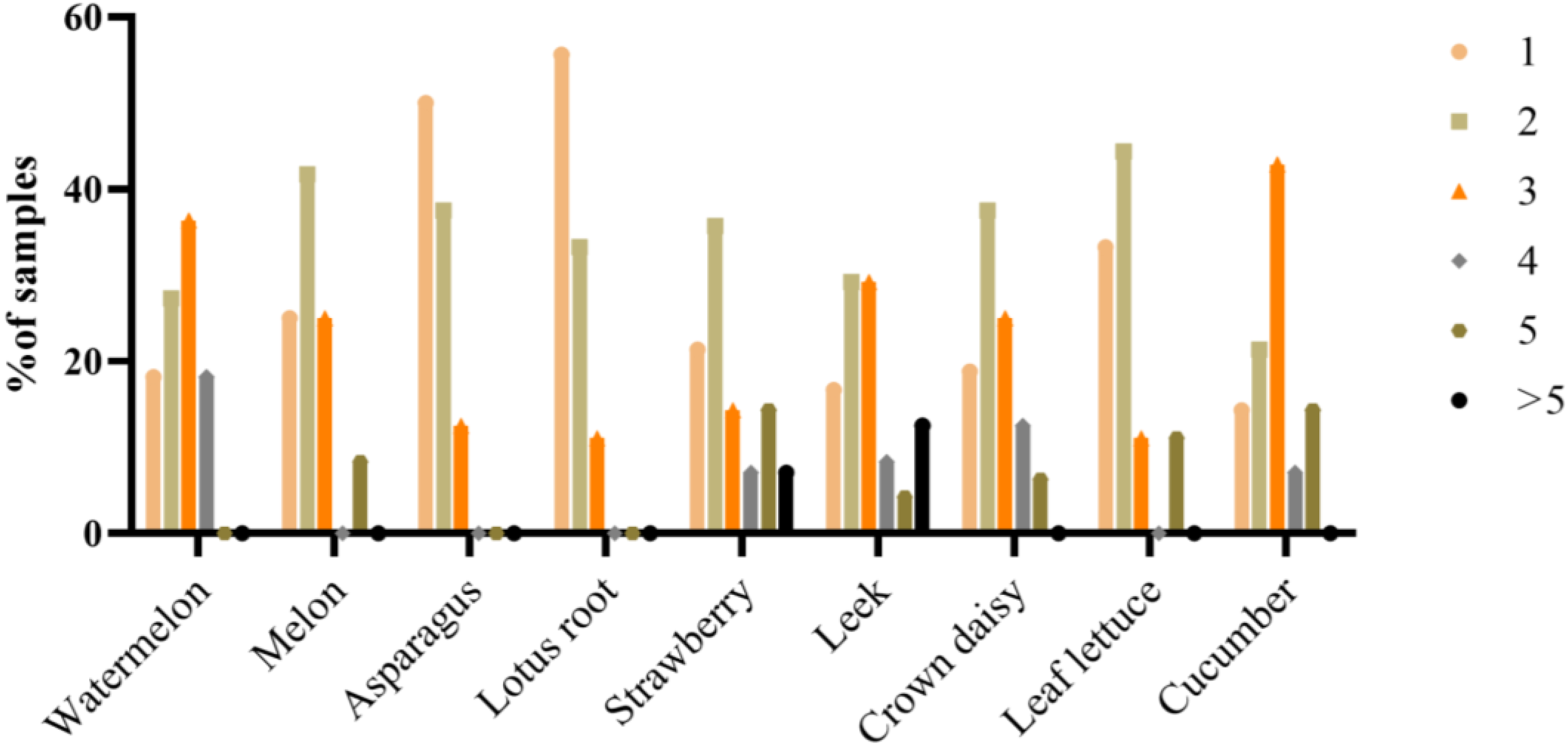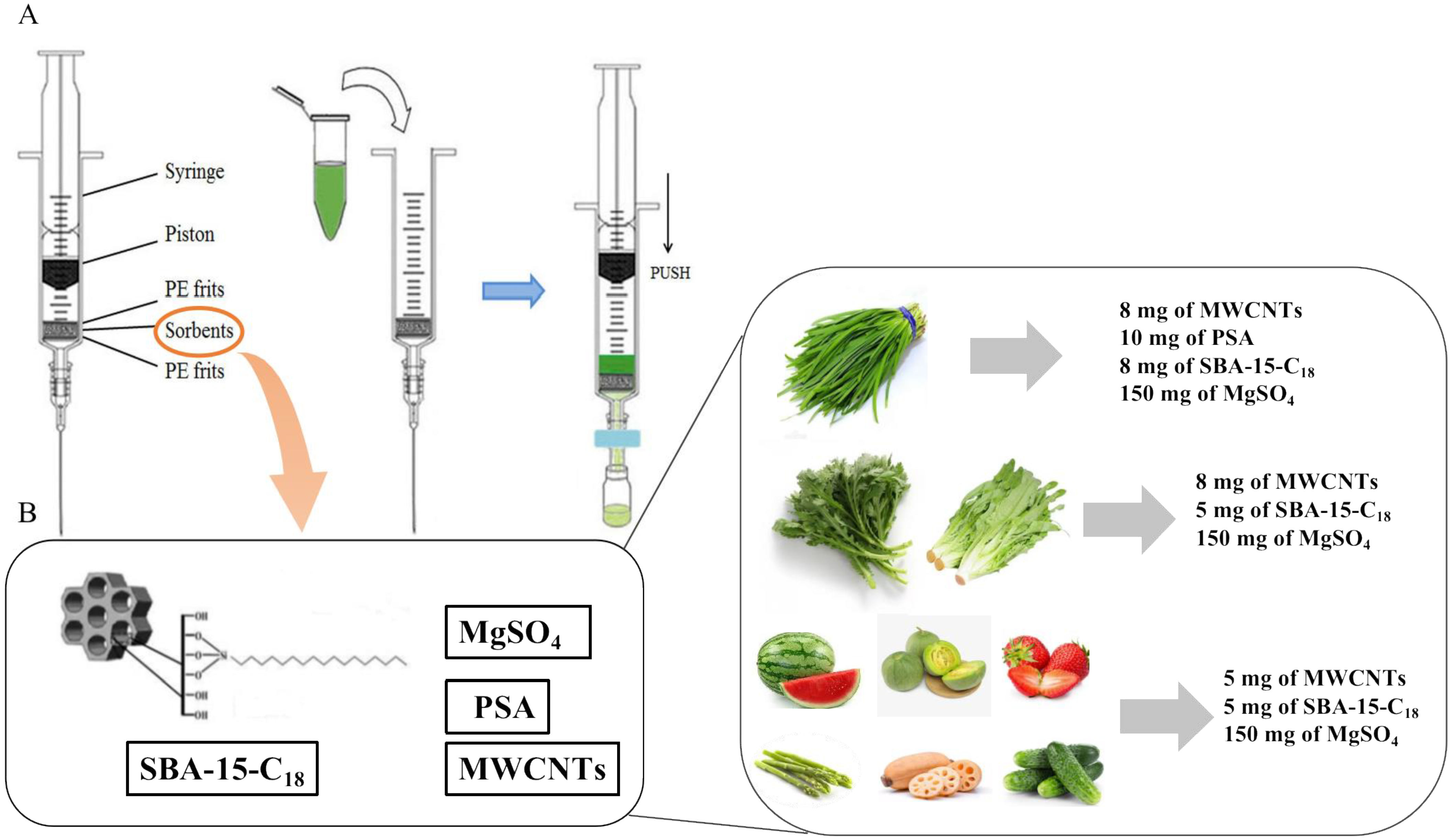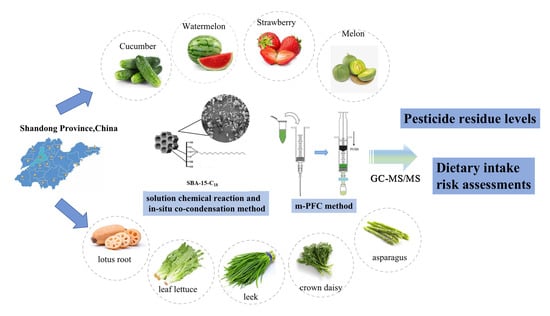Residue Levels and Dietary Intake Risk Assessments of 139 Pesticides in Agricultural Produce Using the m-PFC Method Based on SBA-15-C18 with GC-MS/MS
Abstract
1. Introduction
2. Results and Discussion
2.1. Characterization of SBA-15-C18
2.2. Determination of Pesticide Residues
2.3. Pesticide Residues in Samples
2.3.1. Evaluation by Samples
2.3.2. Evaluation by Pesticides
2.3.3. The Results of Multiple Pesticide Residues
2.4. Risk Assessment of the Long-Term Intake and Chronic Exposure
2.5. Risk Assessment of the Short-Term Intake and Acute Exposure
3. Materials and Methods
3.1. Standards, Reagents and Materials
3.2. Sample Collection
3.3. GC-MS/MS Analytical Conditions
3.4. Preparation and Characterization of SBA-15-C18
3.5. Sample Extraction and Cleanup
3.6. Method Performances
3.7. Intake Risk Assessment
4. Conclusions
Supplementary Materials
Author Contributions
Funding
Institutional Review Board Statement
Informed Consent Statement
Data Availability Statement
Conflicts of Interest
Sample Availability
References
- Walorczyk, S.; Drożdżyński, D.; Kowalska, J.; Remlein-Starosta, D.; Ziółkowski, A.; Przewoźniak, M.; Gnusowski, B. Pesticide residues determination in Polish organic crops in 2007–2010 applying gas chromatography-tandem quadrupole mass spectrometry. Food Chem. 2013, 139, 482–487. [Google Scholar] [CrossRef] [PubMed]
- Bhanti, M.; Taneja, A. Contamination of vegetables of different seasons with organophosphorous pesticides and related health risk assessment in northern India. Chemosphere 2007, 69, 63–68. [Google Scholar] [CrossRef] [PubMed]
- Berrada, H.; Fernández, M.; Ruiz, M.; Moltó, J.; Mañes, J.; Font, G. Surveillance of pesticide residues in fruits from Valencia during twenty months (2004/05). Food Control 2010, 21, 36–44. [Google Scholar] [CrossRef]
- Chen, C.; Qian, Y.Z.; Chen, Q.; Tao, C.J.; Li, C.Y.; Li, Y. Evaluation of pesticide residues in fruits and vegetables from Xiamen, China. Food Control 2011, 22, 1114–1120. [Google Scholar] [CrossRef]
- Philippe, V.; Neveen, A.; Marwa, A.; Basel, A.Y.A. Occurrence of pesticide residuesin fruits and vegetables for the Eastern Mediterranean Region and potential impact on public health. Food Control 2021, 119, 107457. [Google Scholar] [CrossRef]
- Mac Loughlin, T.M.; Peluso, M.L.; Etchegoyen, M.A.; Alonso, L.L.; de Castro, M.C.; Percudani, M.C.; Marino, D.J. Pesticide residues in fruits and vegetables of the argentine domestic market: Occurrence and quality. Food Control 2018, 93, 129–138. [Google Scholar] [CrossRef]
- Juraske, R.; Antón, A.; Castells, F.; Huijbregts, M. Human intake fractions of pesticides via greenhouse tomato. con sumption: Comparing model estimates with measurements for Captan. Chemosphere 2007, 67, 1102–1107. [Google Scholar] [CrossRef]
- Park, D.W.; Yang, Y.S.; Lee, Y.U.; Han, S.J.; Kim, H.J.; Kim, S.H.; Kim, J.P.; Cho, S.J.; Lee, D.; Song, N.J.; et al. Pesticide residues and risk assessment from monitoring programs in the largest production area of leafy vegetables in South Korea: A 15-year study. Foods 2021, 10, 425. [Google Scholar] [CrossRef]
- Lozowicka, B.; Kaczynski, P.; Paritova, A.; Kuzembekova, G.; Abzhalieva, A.; Sarsembayeva, N.; Alihan, K. Pesticide residues in grain from Kazakhstan and potential health risks associated with exposure to detected pesticides. Food Chem. Toxicol. 2014, 64, 238–248. [Google Scholar] [CrossRef]
- Yu, J.; Wang, X.; Yao, X.; Wu, X. Safety Evaluation of Heavy Metal Contamination and Pesticide Residues in Coix Seeds in Guizhou Province, China. Foods 2022, 11, 2286. [Google Scholar] [CrossRef]
- Claeys, W.L.; Schmit, J.-F.; Bragard, C.; Maghuin-Rogister, G.; Pussemier, L.; Schiffers, B. Exposure of several Belgian consumer groups to pesticide residues through fresh fruit and vegetable consumption. Food Control 2011, 22, 508–516. [Google Scholar] [CrossRef]
- Liu, Y.; Li, S.; Ni, Z.; Qu, M.; Zhong, D.; Ye, C.; Tang, F. Pesticides in persimmons, jujubes and soil from China: Residue levels, risk assessment and relationship between fruits and soils. Sci. Total Environ. 2016, 542, 620–628. [Google Scholar] [CrossRef]
- Shoiful, A.; Fujita, H.; Watanabe, I.; Honda, K. Concentrations of organochlorine pesticides (OCPs) residues in Foodstuffs collected from traditional markets in Indonesia. Chemosphere 2013, 90, 1742–1750. [Google Scholar] [CrossRef] [PubMed]
- Jallow, M.F.; Awadh, D.G.; Albaho, M.S.; Devi, V.Y.; Ahmad, N. Monitoring of pesticide residues in commonly used fruits and vegetables in Kuwait. Int. J. Env. Res. Public Health 2017, 14, 833. [Google Scholar] [CrossRef] [PubMed]
- Wu, P.; Wang, P.; Gu, M.; Xue, J.; Wu, X. Human health risk assessment of pesticide residues in honeysuckle samples from different planting bases in China. Sci. Total Environ. 2021, 759, 142747. [Google Scholar] [CrossRef] [PubMed]
- Tsakiris, I.N.; Goumenou, M.; Tzatzarakis, M.N.; Alegakis, A.K.; Tsitsimpikou, C.; Ozcagli, E.; Vynias, D.; Tsatsakis, A.M. Risk assessment for children exposed to DDT residues in various milk types from the Greek market. Food Chem. Toxicol. 2015, 75, 156–165. [Google Scholar] [CrossRef] [PubMed]
- Wu, W.-J.; Qin, N.; Zhu, Y.; He, Q.-S.; Ouyang, H.-L.; He, W.; Xu, F.-L. The residual levels and health risks of hexachlorocyclohexanes (HCHs) and dichloro-diphenyl-trichloroethanes (DDTs) in the fish from Lake Baiyangdian. Environ. Sci. Pollut. Res. 2013, 20, 5950–5962. [Google Scholar] [CrossRef]
- OECD. China OECD Review of Agricultural Policies, Organisation for Economic Co-Operation and Development; OECD: Paris, France, 2005. [Google Scholar]
- Liu, Y.M.; Jinsong, C.; XiaoYong, X.Z.; Kamphuis, B.M. The Vegetable industry in China; Developments in Policies, Production, Marketing and International Trade; Report 6.04.14; Agricultural Economics Research Institute: Den Haag, The Netherlands, 2004. [Google Scholar]
- Zhao, P.; Wang, L.; Zhou, L.; Zhang, F.; Kang, S.; Pan, C. Multi-walled carbon nanotubes as alternative reversed-dispersive solid phase extraction materials in pesticide multi-residue analysis with QuEChERS method. J. Chromatogr. A 2012, 1225, 17–25. [Google Scholar] [CrossRef]
- Zhao, P.; Huang, B.; Li, Y.; Han, Y.; Zou, N.; Gu, K.; Pan, C. Rapid Multiplug Filtration Cleanup with Multiple-Walled Carbon Nanotubes and Gas Chromatography—Triple-Quadruple Mass Spectrometry Detection for 186 Pesticide Residues in Tomato and Tomato Products. J. Agr. Food Chem. 2014, 62, 3710–3725. [Google Scholar] [CrossRef]
- Zou, N.; Han, Y.; Li, Y.; Qin, Y.; Gu, K.; Zhang, J.; Pan, C.; Li, X.S. Multiresidue method for determination of 183 pesticide residues in leeks by rapid multiplug filtration cleanup and gas chromatography-tandem mass spectrometry. J. Agr. Food Chem. 2016, 64, 6061–6070. [Google Scholar] [CrossRef]
- Castiglioni, M.; Onida, B.; Rivoira, L.; Del Bubba, M.; Ronchetti, S.; Bruzzoniti, M.C. Amino groups modified SBA-15 for dispersive-solid phase extraction in the analysis of micropollutants by QuEchERS approach. J. Chromatogr. A 2021, 1645, 462107. [Google Scholar] [CrossRef] [PubMed]
- Hu, Q.; Li, J.J.; Hao, Z.P.; Li, L.D.; Qiao, S.Z. Dynamic adsorption of volatile organic compounds on organofunctionalized SBA-15 materials. Chem Eng. J. 2009, 149, 281–288. [Google Scholar] [CrossRef]
- Mureseanu, M.; Reiss, A.; Stefanescu, I.; David, E.; Parvulescu, V.; Renard, G.; Hulea, V. Modified SBA-15 mesoporous silica for heavy metal ions remediation. Chemosphere 2008, 73, 1499–1504. [Google Scholar] [CrossRef] [PubMed]
- Casado, N.; Pérez-Quintanilla, D.; Morante-Zarcero, S.; Sierra, I. Evaluation of bi-functionalized mesoporous silicas as reversed phase/cation-exchange mixed-mode sorbents for multi-residue solid phase extraction of veterinary drug residues in meat samples. Talanta 2017, 165, 223–230. [Google Scholar] [CrossRef]
- Casado, N.; Pérez-Quintanilla, D.; Morante-Zarcero, S.; Sierra, I. Current development and. applications of ordered mesoporous silicas and other sol-gel silica-based materials in food sample preparation for xenobiotics analysis. TrAC Trend Anal. Chem. 2017, 88, 167–184. [Google Scholar] [CrossRef]
- Casado, N.; Morante-Zarcero, S.; Pérez-Quintanilla, D.; Sierra, I. Application of a hybrid ordered mesoporous silica as sorbent for solid-phase multi-residue extraction of veterinary drugs in meat by ultra-high-performance liquid chromatography coupled to ion-trap tandem mass spectrometry. J. Chromatogr. A 2016, 1459, 24–37. [Google Scholar] [CrossRef]
- Han, Y.; Song, L.; Liu, S.; Zou, N.; Li, Y.; Qin, Y.; Pan, C. Simultaneous determination of 124 pesticide residues in Chinese liquor and liquor-making raw materials (sorghum and rice hull) by rapid multi-plug filtration cleanup and gas chromatography-tandem mass spectrometry. Food Chem. 2018, 241, 258–267. [Google Scholar] [CrossRef]
- Wang, X.; Wang, X.; Zhang, H.; Wu, C.; Wang, X.; Xu, H.; Li, Z. Enantioselective degradation of tebuconazole in cabbage, cucumber, and soils. Chirality 2012, 24, 104–111. [Google Scholar] [CrossRef]
- Chen, L.; Li, X.S.; Wang, Z.Q.; Pan, C.P.; Jin, R.C. Residue dynamics of procymidone in leeks and soil in greenhouses by smoke generator application. Ecotoxicol. Environ. Saf. 2010, 73, 73–77. [Google Scholar] [CrossRef]
- He, Z.; Chen, S.; Wang, L.; Peng, Y.; Luo, M.; Wang, W.; Liu, X. Multiresidue analysis of 213 pesticides in leek and garlic using QuEChERS-based method and gas chromatography-triple quadrupole mass spectrometry. Anal. Bioanal. Chem. 2015, 407, 2637–2643. [Google Scholar] [CrossRef]





| Samples | Triadimenol | Procymidone | Chlorpyrifos | Cypermethrin |
|---|---|---|---|---|
| MRL/Detected Quantity (mg/kg) | MRL/Detected Quantity (mg/kg) | MRL/Detected Quantity (mg/kg) | MRL/Detected Quantity (mg/kg) | |
| Melon | 0.2/0.320 | - | - | - |
| Strawberry | - | - | - | 0.07/0.340 |
| Leek1 | - | 0.2/11.270 | - | - |
| Leek 2 | - | 0.2/10.560 | - | - |
| Leek 3 | - | 0.2/5.430 | - | - |
| Leaf lettuce 1 | - | - | 0.02/0.933 | - |
| Leaf lettuce 2 | - | - | - | 2/2.344 |
| Cucumber 1 | - | 2/2.334 | - | - |
| Cucumber 2 | 0.2/0.510 | - | - | - |
| Pesticide | ADI (mg/kg·bw·d) | Long-Term Risk | Pesticide | ADI (mg/kg·bw·d) | Long-Term Risk | ||
|---|---|---|---|---|---|---|---|
| IEDI (µg/kg·bw·d) | ADI% | IEDI (µg/kg·bw·d) | ADI% | ||||
| Acetochlor | 0.02 | 0.30 | 1.5 | Flusilazole | 0.007 | 0.00 | 0.0 |
| Alachlor | 0.01 | 0.01 | 0.1 | Flutolanil | 0.09 | 0.00 | 0.0 |
| Ametryn | 0.072 | 0.00 | 0.0 | Kresoxim-methyl | 0.4 | 0.02 | 0.0 |
| Anilofos | 0.001 | 0.02 | 2.2 | Mefenacet | 0.007 | 0.01 | 0.2 |
| Atrazine | 0.02 | 0.30 | 1.5 | Mepronil | 0.05 | 0.00 | 0.0 |
| Azoxystrobin | 0.2 | 0.01 | 0.0 | Methidathion | 0.001 | 0.00 | 0.0 |
| Cypermethrin | 0.02 | 0.32 | 1.6 | Myclobutanil | 0.03 | 0.01 | 0.0 |
| Bifenthrin | 0.01 | 0.01 | 0.1 | DDT | 0.01 | 0.01 | 0.1 |
| Boscalid | 0.04 | 0.00 | 0.0 | Oxyfluorfen | 0.03 | 0.14 | 0.5 |
| Bromoxynil | 0.01 | 0.00 | 0.0 | Parathion | 0.004 | 0.00 | 0.0 |
| Butachlor | 0.1 | 0.03 | 0.0 | Pendimethalin | 0.03 | 0.01 | 0.0 |
| Butralin | 0.2 | 0.00 | 0.0 | Phenthoate | 0.003 | 0.01 | 0.3 |
| Chlorfenapyr | 0.03 | 0.04 | 0.1 | Pirimicarb | 0.02 | 0.00 | 0.0 |
| Chlorpropham | 0.05 | 0.00 | 0.0 | Probenazole | 0.07 | 0.01 | 0.0 |
| Chlorpyrifos | 0.01 | 0.04 | 0.4 | Procymidone | 0.1 | 0.11 | 0.1 |
| Clodinafop-propargyl | 0.0003 | 0.17 | 5.5 | Profenofos | 0.03 | 0.09 | 0.3 |
| Cyfluthrin | 0.04 | 0.23 | 0.6 | Prometryn | 0.04 | 0.03 | 0.1 |
| Cyhalothrin | 0.02 | 0.07 | 0.3 | Propachlor | 0.54 | 0.29 | 0.1 |
| Cyprodinil | 0.03 | 0.00 | 0.0 | Propargite | 0.01 | 0.00 | 0.0 |
| Deltamethrin | 0.01 | 0.04 | 0.4 | Propiconazole | 0.07 | 0.02 | 0.0 |
| Diclofop-methyl | 0.0023 | 0.00 | 0.1 | Diethofencarb | 0.004 | 0.01 | 0.2 |
| Difenzoquat | 0.25 | 0.03 | 0.1 | Pyriproxyfen | 0.1 | 0.02 | 0.0 |
| Endosulfan | 0.006 | 0.04 | 0.6 | Quinalphos | 0.0005 | 0.01 | 1.4 |
| Endrin | 0.0002 | 0.02 | 9.5 | Quizalofop | 0.0009 | 0.01 | 0.6 |
| Famoxadone | 0.006 | 0.00 | 0.0 | Spirodiclofen | 0.01 | 2.42 | 24.2 |
| Fenarimol | 0.01 | 0.01 | 0.1 | Tebuconazole | 0.03 | 0.07 | 0.2 |
| Fenbuconazole | 0.03 | 0.01 | 0.0 | Terbufos | 0.0006 | 0.00 | 0.0 |
| Fenobucarb | 0.06 | 0.23 | 0.4 | Tolfenpyrad | 0.006 | 0.00 | 0.0 |
| Fenpropathrin | 0.03 | 0.03 | 0.1 | Triadimefon | 0.03 | 0.03 | 0.1 |
| Fipronil | 0.0002 | 0.00 | 0.0 | Triadimenol | 0.03 | 0.10 | 0.3 |
| Fenthion | 0.007 | 0.00 | 0.0 | Triallate | 0.025 | 0.02 | 0.1 |
| Fluazifop-P-butyl | 0.004 | 0.17 | 2.3 | Trifloxystrobin | 0.04 | 0.02 | 0.0 |
| Fluroxypyr | 1 | 0.03 | 0.0 | Trifluralin | 0.025 | 0.03 | 0.1 |
| Pesticide | ARfD (mg/kg·bw·d) | Commodity | Short-Term Risk | Pesticide | ARfD (mg/kg·bw·d) | Commodity | Short-Term Risk | ||
|---|---|---|---|---|---|---|---|---|---|
| IESTI (µg/kg·bw·d) | ARfD% | IESTI (µg/kg·bw·d) | ARfD% | ||||||
| Atrazine | 0.1 | Melon | 0.37 | 0.4 | Fenpropathrin | 0.03 | Leaf lettuce | 0.44 | 1.5 |
| Watermelon | 0.49 | 0.5 | Fenpropathrin | 0.03 | Melon | 0.25 | 0.8 | ||
| Asparagus | 0.07 | 0.1 | Fenthion | 0.01 | Leek | 0.04 | 0.4 | ||
| Cypermethrin | 0.04 | Strawberry | 0.32 | 0.8 | Asparagus | 0.05 | 0.5 | ||
| Leek | 0.62 | 1.6 | Flusilazole | 0.02 | Melon | 0.55 | 2.8 | ||
| Melon | 5.23 | 13.1 | Methidathion | 0.01 | Leaf lettuce | 0.15 | 1.5 | ||
| Cucumber | 1.04 | 2.6 | Myclobutanil | 0.3 | Strawberry | 8.57 | 2.9 | ||
| Leaf lettuce | 0.53 | 1.3 | Cucumber | 0.30 | 0.1 | ||||
| Bifenthrin | 0.01 | Melon | 1.22 | 12.2 | Leaf lettuce | 0.90 | 0.3 | ||
| Leaf lettuce | 1.21 | 12.1 | Pirimicarb | 0.1 | Asparagus | 0.04 | 0.0 | ||
| Asparagus | 0.19 | 1.9 | Procymidone | 0.1 | Strawberry | 2.90 | 2.9 | ||
| Chlorfenapyr | 0.03 | Leek | 14.76 | 49.2 | Leek | 58.30 | 58.3 | ||
| Chlorpropham | 0.5 | Asparagus | 0.05 | 0.0 | Melon | 13.56 | 13.6 | ||
| Chlorpyrifos | 0.1 | Strawberry | 0.37 | 0.4 | Cucumber | 2.67 | 2.7 | ||
| Leek | 1.60 | 1.6 | Watermelon | 4.34 | 4.3 | ||||
| Melon | 8.09 | 8.1 | Leaf lettuce | 46.81 | 46.8 | ||||
| Cucumber | 0.45 | 0.5 | Asparagus | 0.08 | 0.1 | ||||
| Leaf lettuce | 0.17 | 0.2 | Profenofos | 1 | Strawberry | 5.24 | 0.5 | ||
| Asparagus | 5.89 | 5.9 | Cucumber | 2.32 | 5.8 | ||||
| Cyfluthrin | 0.04 | Strawberry | 0.32 | 0.8 | Leaf lettuce | 0.55 | 1.4 | ||
| Leek | 0.59 | 1.5 | Cyhalothrin | 0.02 | Strawberry | 0.17 | 0.9 | ||
| Melon | 1.65 | 4.1 | Leek | 0.08 | 0.4 | ||||
| Melon | 0.40 | 2.0 | Watermelon | 10.20 | 1.0 | ||||
| Leaf lettuce | 0.32 | 1.6 | Propiconazole | 0.3 | Leaf lettuce | 0.83 | 0.3 | ||
| Deltamethrin | 0.05 | Strawberry | 0.16 | 0.3 | Tebuconazole | 0.3 | Strawberry | 2.21 | 0.7 |
| Leek | 0.09 | 0.2 | Melon | 0.88 | 0.3 | ||||
| Melon | 0.37 | 0.7 | Cucumber | 0.20 | 0.1 | ||||
| Leaf lettuce | 0.22 | 0.4 | Watermelon | 1.19 | 0.4 | ||||
| Endosulfan | 0.02 | Strawberry | 3.80 | 19.0 | Leaf lettuce | 2.81 | 0.9 | ||
| Leek | 0.06 | 0.3 | Asparagus | 10.11 | 3.4 | ||||
| Melon | 0.67 | 3.4 | |||||||
| Cucumber | 1.47 | 7.4 | Tolfenpyrad | 0.01 | Cucumber | 0.07 | 0.7 | ||
| Leaf lettuce | 0.85 | 4.3 | Triadimefon | 0.08 | Strawberry | 0.08 | 0.1 | ||
| Famoxadone | 0.6 | Leaf lettuce | 0.50 | 0.1 | Leek | 0.08 | 0.1 | ||
| buconazole | 0.2 | Cucumber | 0.34 | 0.2 | Leaf lettuce | 0.44 | 0.6 | ||
| Watermelon | 0.60 | 0.3 | Triadimenol | 0.08 | Melon | 9.83 | 12.3 | ||
| Melon | 3.57 | 0.4 | Watermelon | 16.96 | 21.2 | ||||
Disclaimer/Publisher’s Note: The statements, opinions and data contained in all publications are solely those of the individual author(s) and contributor(s) and not of MDPI and/or the editor(s). MDPI and/or the editor(s) disclaim responsibility for any injury to people or property resulting from any ideas, methods, instructions or products referred to in the content. |
© 2023 by the authors. Licensee MDPI, Basel, Switzerland. This article is an open access article distributed under the terms and conditions of the Creative Commons Attribution (CC BY) license (https://creativecommons.org/licenses/by/4.0/).
Share and Cite
Wang, Y.; Huang, T.; Zhang, T.; Ma, X.; Zhou, G.; Chi, M.; Geng, X.; Yuan, C.; Zou, N. Residue Levels and Dietary Intake Risk Assessments of 139 Pesticides in Agricultural Produce Using the m-PFC Method Based on SBA-15-C18 with GC-MS/MS. Molecules 2023, 28, 2480. https://doi.org/10.3390/molecules28062480
Wang Y, Huang T, Zhang T, Ma X, Zhou G, Chi M, Geng X, Yuan C, Zou N. Residue Levels and Dietary Intake Risk Assessments of 139 Pesticides in Agricultural Produce Using the m-PFC Method Based on SBA-15-C18 with GC-MS/MS. Molecules. 2023; 28(6):2480. https://doi.org/10.3390/molecules28062480
Chicago/Turabian StyleWang, Yue, Tingjie Huang, Tao Zhang, Xiaoping Ma, Guangshuo Zhou, Meiyao Chi, Xinjie Geng, Chunhao Yuan, and Nan Zou. 2023. "Residue Levels and Dietary Intake Risk Assessments of 139 Pesticides in Agricultural Produce Using the m-PFC Method Based on SBA-15-C18 with GC-MS/MS" Molecules 28, no. 6: 2480. https://doi.org/10.3390/molecules28062480
APA StyleWang, Y., Huang, T., Zhang, T., Ma, X., Zhou, G., Chi, M., Geng, X., Yuan, C., & Zou, N. (2023). Residue Levels and Dietary Intake Risk Assessments of 139 Pesticides in Agricultural Produce Using the m-PFC Method Based on SBA-15-C18 with GC-MS/MS. Molecules, 28(6), 2480. https://doi.org/10.3390/molecules28062480






